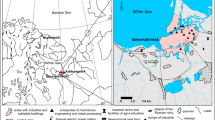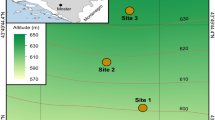Abstract
Nine metals (Al, Ba, Cr, Cu, Fe, Mn, Pb, V, and Zn) and three natural radionuclides (40K, 238U, and 232Th) were quantitatively determined in the cultivated and uncultivated soils of the Bahariya Oasis where the main mines of the Egyptian iron ore are located. The mean concentrations of Ba, Cr, Cu, Fe, V in the cultivated soils and Al, Cr, Cu, V in the uncultivated soils exceed maximum allowable concentration (MAC). The evaporites-rich uncultivated soils contain high concentrations of Zn. The contamination degrees (Cd) of the cultivated and evaporites-rich uncultivated soils were represented by moderate to extremely high values. All metals are spatially varied and their highest values are recorded in the northern parts of the oasis close to the iron mines. The highest values of the activity concentrations of 40K were recorded in the evaporites-rich uncultivated soils. On the other side, the highest values of 238U, 232Th were recorded in the cultivated soils. The cultivated soils samples show higher values of the total absorbed external gamma dose rate (D) and annual effective dose (AED) than the international recommended values (54 nGy/h and 0.07 mSv/y; respectively). The external hazard index (Hex) for all studied soils are mainly lower than unity. The origin of Bahariya soils is lithogenic and anthropogenic, whereas the role played by groundwater flow, evaporation of near-surface saline groundwater, and phosphatic fertilizers in the soil contamination is more effective than those of iron ore erosion.




Similar content being viewed by others
References
Abd El-Rahman SM, Kassim YS, El-Hussiny N (1986) Statistical particle size analysis of Bahariya soils as criteria for their origin and formation. Egyptian Journal of Desert Research 36(2):273–283
Abrahim G, Parker R (2008) Assessment of heavy metal enrichment factors and the degree of contamination in marine sediments from Tamaki Estuary, Auckland. New Zealand Environmental Monitoring and Assessment 136:227–238
Alloway BJ (2012) Heavy metals in soils. Springer, Netherlands
Alshahri F, Alqahtani M (2015) Chemical fertilizers as a source of 238U, 40K, 226Ra, 222Rn, and trace metal pollutant of the environment in Saudi Arabia. Environ Sci Pollut Res 22:8339–8348
Arhin E, Boansi AO, Zango MS (2016) Trace elements distributions at Datoko-Shega artisanal mining site, northern Ghana. Environ Geochem Health 38:203–218
Aykol A, Budakoglu M, Kumral M, Gultekin AH, Turhan M, Esenli V, Yavuz F, Orgun Y (2003) Heavy metal pollution and acid drainage from the abandoned Balya Pb-Zn sulfide mine, NW Anatolia, Turkey. Environ Geol 45:198–208
Baghdady AR, Gad A (2013) Textural and mineral attributes and sedimentary history of the various Quaternary soil types in the Bahariya Oasis, Western Desert, Egypt. Sedimentol Egypt 21:105–117
Baioumy HM, Ahmed AH, Khedr MZ (2014) Amixed hydrogenous and hydrothermal origin of the Bahariya iron ores, Egypt: evidences from the trace and rare earth element geochemistry. J Geochem Explor 146:149–162
Belivermis M, Kılıç O, Çotuk Y, Topcuoglu S (2010) The effects of physicochemical properties on gamma emitting natural radionuclide levels in the soil profile of Istanbul. Environ Monit Assess 163:15–26
Beretka J, Mathew PJ (1985) Natural radioactivity of Australian building materials waste and bi-products. Health Phys 48(1):87–95
Briki M, Ji H, Li C, Ding H, Gao Y (2015) Characterization, distribution and risk assessment of heavy metals in agricultural soil and product around mining areas of Hezhag, China. Environ Monit Assess 187:767–788
Cai L, Xu Z, Ren M, Guo HX, Hu G, Wan H, Peng P (2012) Source identification of eight hazardous heavy metals in agricultural soils of Huizhou, Guangdong Province, China. Ecotoxicol Environ Saf 78:2–8
Catuneanu O, Khalifa MA, Wanas HA (2006) Sequence stratigraphy of the Lower Cenomanian Bahariya Formation, Bahariya Oasis, Western Desert, Egypt. Sediment Geol 190:121–137
CCME (Canadian Council of Ministers of the Environment) (2013) Canadian soil quality guidelines for the protection of environmental and human health. Canadian Council of Ministers of the Environment, Winnipeg, Summary tables, p. 6
Chen TB, Zheng YM, Lei M, Huang ZC, Wu HT, Chen H, Fan KK, Yu K, Wu X, Tian QZ (2005) Assessment of heavy metal pollution in surface soils of urban parks in Beijing, China. Chemosphere 60:542–551
Chen L, Zhou S, Wu S, Wang C, Li B, Li Y, Wang J (2018) Combining emission inventory and isotope ratio analyses for quantitative source apportionment of heavy metals in agricultural soil. Chemosphere 204:140–147
Ciobota V, Salama W, Tarcea N, Rösch R, El Aref M, Gaupp R, Popp J (2012) Identification of minerals and organic materials of the Middle Eocene ironstones, the Bahariya Depression, Western Desert, Egypt by means of micro-Raman spectroscopy. J Raman Spectrosc 43(3):405–410
Dabous AA (2002) Uranium isotopic evidence for the origin of the Bahariya iron deposits, Egypt. Ore Geol Rev 19:165–186
Du CY, Zu YQ, Li Y (2005) Effects of pH and organic matter on the bioavailability of Cd and Zn in soil. Journal of Yunnan Agricultural University 20:539–543
El Kashouty M, Abdel Aziz A, Soliman M, Mesbah H (2012) Hydrogeophysical investigation of groundwater potential in El Bawiti, northern Bahariya Oasis, Western Desert, Egypt. Arab J Geosci 5:953–970
El Shiekh HA, Amer M (1990) Paleoenvironments of the Quaternary soils in El Bahariya Oasis, Western Desert, Egypt. Geol Surv Egypt XVI:255–258
El-Bahi SM (2003) Radioactivity levels of salt for natural sediments in the northwestern desert and local markets in Egypt. Appl Radiat Isot 58:143–148
El-Sadek MA, Ammar AA, Omran MA, Abu-Elkheer HM (2011) Airborne γ-ray spectrometric characteristics of lithological units and environmental issues in the Bahariya Oases area in the northern part of western desert, Egypt. Arab J Geosci 4:1151–1161
Gross MG (1971) Carbon determination. In: Carver RE (ed) Procedures in sedimentary petrology. Wiley-Interscience, New York, pp 573, 653–596
Hakanson L (1980) An ecological risk index for aquatic pollution control: a sedimentological approach. Water Res 14:975–1001
Kabata-Pendias A (2011) Trace elements in soils and plants, 4th edn. CRC Press, NY
Khalifa M, Gad A (2018) Assessment of heavy metals contamination in agricultural soil of Southwestern Nile Delta, Egypt. Soil Sediment Contam Int J 27(7):619–642
Khalil JB, Labib FB (1980) The mineralogical nature of silt and sand deposits in Bahariya Oasis. Egypt J Soil Sci 20(1):45–56
Kim R, Yoon J, Kim T, Yang JE, Owens G, Kim K (2015) Bioavailability of heavy metals in soils: definitions and practical implementation—a critical review. Environ Geochem Health 37:1041–1061
Lakehal C, Ramdhane M, Boucenna A (2010) Natural radionuclide concentrations in two phosphate ores of east Algeria. J Environ Radioact 101:377–379
Leach DL, Song YC, Hou ZQ (2017) The world-class Jinding Zn–Pb deposit: ore formation in an evaporite dome, Lanping Basin, Yunnan, China. Mineral Deposita 52(3):281
Lee J, Chon H, Kim K (2005) Human risk assessment of As, Cd, Cu and Zn in the abandoned metal mine site. Environ Geochem Health 27:185–191
Lewis DW, McConchie D (1994) Analytical sedimentology. Springer, Netherlands
Littlejohn D, Egila JN, Gosland RM, Kunwar UK, Smith C (1991) Graphite furnace analysis. Anal Chim Acta 250:71–84
Momčilović M, Kovačević J, Tanić M, Đorđević M, Bačić G, Dragović S (2013) Distribution of natural radionuclides in surface soils in the vicinity of abandoned uranium mines in Serbia. Environ Monit Assess 185:1319–1329
Moore F, Dehbandi R, Keshavarzi B, Amjadian K (2016a) Potentially toxic elements in the soil and two indigenous plant species in Dashkasan epithermal gold mining area, West Iran. Environ Earth Sci 75(3):268
Moore F, Sheykhi V, Salari M, Bagher A (2016b) Soil quality assessment using GIS-based chemometric approach and pollution indices. Nakhlak mining district, Central Iran. Environ Monit Assess 188:214–230
Nakhla FM, Shehata MN (1967) Contributions to the mineralogy and geochemistry of some iron-ore deposits in Egypt (U.A.R.). Mineral Deposita 2:357–371
Okedeyi OO, Dube S, Awofolu OR, Nindi MM (2014) Assessing the enrichment of heavy metals in surface soil and plant (Digitaria eriantha) around coal-fired power plants in South Africa. Environ Sci Pollut Res 21:4686–4696
Pillai GS, Hameed PS, Khan SM (2016) Natural radioactivity levels in the soils and human risk assessment in Tiruchirappalli district (Tamil Nadu, India). J Radioanal Nucl Chem 307:1265–1277
Rashed M, Shalaby EA (2007) Dispersion and deposition of heavy metals around two municipal solid waste (MSW) dump sites Alexandria. Am Eurasian J Agric Environ Sci 2:204–212
Said R (1962) The geology of Egypt. Elsevier Sci, Amsterdam
Said R, Issawi B (1964) Geology of northern plateau, Bahariya Oasis, Egypt. Geological Survey of Egypt, Paper No.29, p. 41
Salama W, El Aref M, Gaupp R (2012) Mineralogical and geochemical investigations of the middle Eocene ironstones, El Bahariya depression, western desert, Egypt. Gondwana Res 22(2):717–736
Salem SM (2017) ASD field hyperspectral measurements for discrimination of the ferruginous rocks and the iron ore types at El Gedida-Ghorabi area, Bahariya Oasis, Western Desert, Egypt. Arab J Geosci 10:166. https://doi.org/10.1007/s12517-017-2944-x
Steinnes E (2009) Soils and geomedicine. Environ Geochem Health 31:523–535
Tsai T, Liu C, Chuang C, Wei H, Men L (2011) The effects of physico-chemical properties on natural radioactivity levels, associated dose rate and evaluation of radiation hazard in the soil of Taiwan using statistical analysis. J Radioanal Nucl Chem 288:927–936
Tufail M, Asghar M, Akram M, Javied S, Khan K, Mujahid SA (2013) Measurement of natural radioactivity in soil from Peshawar basin of Pakistan. J Radioanal Nucl Chem 298:1085–1096
UNSCEAR (1988) Sources effects and risks of ionizing radiation. United Nations Scientific Committee on the effects of atomic radiation, report to the general assembly, with annexes. United Nation, New York
UNSCEAR (2000) Sources effects and risks of ionizing radiation. United Nations Scientific Committee on the effects of atomic radiation, report to the general assembly, with annexes. United Nation, New York
UNSCEAR (2008) Sources effects and risks of ionizing radiation. United Nations Scientific Committee on the effects of atomic radiation, report to the general assembly, with annexes. United Nation, New York
Van Reeuwijk LP (2002) Procedures for soil analysis, 6th edn. Wageningen, Netherlands, International Soil Reference and Information Centre
Wahsha M, Bini C, Agrese E, Minello F, Fontana S, Wahsheh H (2012) Heavy metals accumulation in willows growing on Spolic Technosols from the abandoned Imperina Valley mine in Italy. J Geochem Explor 123:19–24
Wasim M, Iqbal S, Ali M (2016) Radiological and elemental analysis of soils from Hunza in Central Karakoram using gamma-ray spectrometry and k0-instrumental neutron activation analysis. J Radioanal Nucl Chem 307:891–898
Weng LP, Temminghoff EJM, Lofts S, Tipping E, Riemsdijk WHV (2002) Complexation with dissolved organic matter and solubility controls of heavy metals in a sandy soil. Environ Sci Technol 36:4804–4810
Yehia M, Baghdady A, Howari FM, Awad S, Gad A (2017) Natural radioactivity and groundwater quality assessment in the northern area of the Western Desert of Egypt. Journal of Hydrology: Regional Studies 12:331–344
Zhang XY, Lin FF, Wong MTF, Feng XL, Wang K (2009) Identification of soil heavy metal sources from anthropogenic activities and pollution assessment of Fuyang County, China. Environ Monit Assess 154:439–449
Acknowledgments
The authors acknowledge Prof. Mohamed M. Yehia (Central Laboratory for Environmental Quality Monitoring, National Water Research Center, El Qanater) for help during the chemical analyses of samples. Also, we are greatly indebted to Prof. Mohamed. M. Abu-Zeid (Ain Shams University) for revising the manuscript and providing valuable comments.
Author information
Authors and Affiliations
Corresponding author
Electronic supplementary material
ESM 1
(DOC 35 kb)
Rights and permissions
About this article
Cite this article
Baghdady, A., Awad, S. & Gad, A. Assessment of metal contamination and natural radiation hazards in different soil types near iron ore mines, Bahariya Oasis, Egypt. Arab J Geosci 11, 506 (2018). https://doi.org/10.1007/s12517-018-3814-x
Received:
Accepted:
Published:
DOI: https://doi.org/10.1007/s12517-018-3814-x




